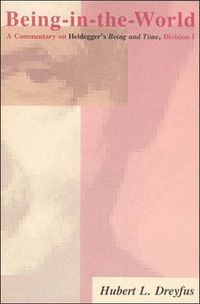
endast ny
Being-in-the-World
Being-in-the-World is a guide to one of the most influential philosophical works of this century: Division I of Part One of Being and Time, where Martin Heidegger works out an original and powerful account of being-in-the-world which he then uses to ground a profound critique of traditional ontology and epistemology. Hubert Dreyfus's commentary opens the way for a new appreciation of this difficult philosopher, revealing a rigorous and illuminating vocabulary that is indispensable for talking about the phenomenon of world.The publication of Being and Time in 1927 turned the academic world on its head. Since then it has become a touchstone for philosophers as diverse as Marcuse, Sartre, Foucault, and Derrida who seek an alternative to the rationalist Cartesian tradition of western philosophy. But Heidegger's text is notoriously dense, and his language seems to consist of unnecessarily barbaric neologisms; to the neophyte and even to those schooled in Heidegger thought, the result is often incomprehensible.Dreyfus's approach to this daunting book is straightforward and pragmatic.He explains the text by frequent examples drawn from everyday life, and he skillfully relates Heidegger's ideas to the questions about being and mind that have preoccupied a generation of cognitive scientists and philosophers of mind.Hubert L. Dreyfus is Professor of Philosophy at the University of California, Berkeley.
Utgiven: 1990
ISBN: 9780262540568
Förlag: MIT Press
Format: Häftad
Språk: Engelska
Sidor: 384 st
Being-in-the-World is a guide to one of the most influential philosophical works of this century: Division I of Part One of Being and Time, where Martin Heidegger works out an original and powerful account of being-in-the-world which he then uses to ground a profound critique of traditional ontology and epistemology. Hubert Dreyfus's commentary opens the way for a new appreciation of this difficult philosopher, revealing a rigorous and illuminating vocabulary that is indispensable for talking about the phenomenon of world.The publication of Being and Time in 1927 turned the academic world on its head. Since then it has become a touchstone for philosophers as diverse as Marcuse, Sartre, Foucault, and Derrida who seek an alternative to the rationalist Cartesian tradition of western philosophy. But Heidegger's text is notoriously dense, and his language seems to consist of unnecessarily barbaric neologisms; to the neophyte and even to those schooled in Heidegger thought, the result is often incomprehensible.Dreyfus's approach to this daunting book is straightforward and pragmatic.He explains the text by frequent examples drawn from everyday life, and he skillfully relates Heidegger's ideas to the questions about being and mind that have preoccupied a generation of cognitive scientists and philosophers of mind.Hubert L. Dreyfus is Professor of Philosophy at the University of California, Berkeley.
Ny bok
602 kr633 kr
5% studentrabatt med Studentapan
Begagnad bok (0 st)
Varje vecka tillkommer tusentals nya säljare. Bevaka boken så får du meddelande när den finns tillgänglig igen.



